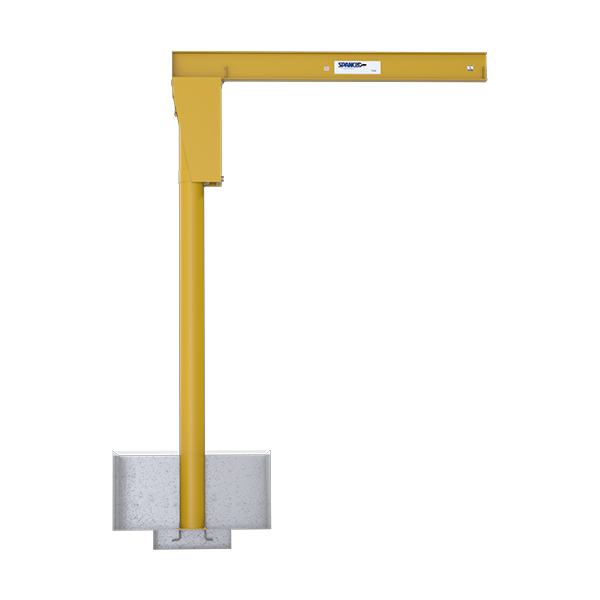Spanco Cranes Improve the Production Process at Aeronautics Company
Overview
Lockheed Martin Aeronautics Company is the leading global security, information technology, and aerospace company in the world. Conducting the majority of their business with the U.S. Department of Defense and federal government agencies, Lockheed Martin is not only the largest provider of IT services, systems integration, and training to the U.S. Government, but they are also known for building the finest military aircraft in the world.
The Aeronautics’ company is a major unit of Lockheed Martin, and its products play an important role in the defense of the United States and many other countries around the world. While Lockheed Martin Aeronautics facilities are located all over the Country, the Lockheed Martin Aeronautics facility in Fort Worth, Texas is their headquarters. The Aeronautics facility, also referred to as Air Force Plant 4, is the home of the F-16 Fighting Falcon and the F-35 Lightning II.
At one time, the facility used multiple 5-ton monorail cranes in their plants to facilitate their production process. The cranes were used to move and install plane parts, and they required the help of multiple production workers to function correctly. But, over the past several years, Lockheed Martins’ Aeronautics facility began to upgrade their production process, thereby replacing many of their monorail cranes with customized freestanding jib cranes from Spanco.
Solution
The production team at Air Force Plant 4 now uses Spanco Jib Cranes to manufacture and assemble their F-16 and F-35 fighter jets. In the F-16 production process, workers use Spanco Jib Cranes to make the fuselage, or the main body of the plane. The production team needed to install cranes that could lift the enormous fuselage from a very small workstation area before transferring it to the CNC machining center. The machining center is used to shape the fuselage and other massive parts, all of which are assembled using Spanco Jib Cranes. Each jib crane is fitted with a jib drive assembly for motorized rotation, which improves handling and ensures total control over load positioning in an area that is generally inaccessible to material handling equipment.
Along with the fuselage, the jib cranes are used to machine and assemble wings for the F-16 Fighting Falcon. Workers use the jib cranes to lift big blocks of aluminum, which are transferred to the machining center where they are shaped and eventually drilled and bolted. After the wings are prepared to receive rivets and screws, workers also use the jib cranes to assemble the wings to the fuselage.
In addition to jib cranes, Lockheed Martin Aeronautics also installed Spanco Freestanding Workstation Bridge Cranes in their Fort Worth, Texas and Marietta, Georgia facilities. The bridge cranes are used to manufacture parts for their new F-35 Lightening II Fighter jets. According to Ken Ross, Lockheed Martin’s Director of Communications & Public Affairs, their production team needed a bridge crane that was lightweight and specifically designed to meet their unique applications. Ross explained, “Clearances were very tight and Spanco provided a very low-profile, lightweight bridge crane for us that also cantilevered out into the aisle so that we could unload components. This was a pretty unique application.” The bridge cranes are used to produce the center wing build-up sections of the F-35 in a very tight workspace where they have to squeeze parts in beneath a mezzanine. The bridge cranes are lightweight enough to fit into the small workspace, and yet durable enough to move heavy parts.
Most recently, Air Force Plant 4 also integrated the use of Spanco Bridge Cranes in their tire center to mount tires onto the wheels of the F-35 and F-16. The addition of Spanco Bridge Cranes has given workers at the tire center in the Fort Worth facility the assistance they need to finish their work quickly and effectively. This has greatly increased their productivity while also providing a safer environment for workers and their production team. Spanco Freestanding Workstation Bridge Cranes provide highly effective, cost efficient lifting and moving solutions, with more than enough overhead crane coverage to supplement a large work area, and yet the precise accuracy to function in a small space.
Impact
The decision to replace monorail cranes with Spanco Jib Cranes and to install Spanco Bridge Cranes in two of their facilities has allowed them to increase efficiency and introduce a more ergonomic assembly process. The freestanding jib cranes are sleeve mounted with a span of 12 feet and a height of 24 feet under the boom. The sleeve mounted jib crane allows for 360 degrees of rotation, which maximizes the use of floor space below the crane. Choosing to sleeve mount the mast means that workers can relocate their jib cranes without ever causing damage to the mast or the foundation. During the installation process, the sleeve is welded to a square steel plate, which positions and plumbs the sleeve by anchoring it to the first-pour concrete footing. The second-pour supports the sleeve. The mast is then placed into the sleeve, leveled by wedges, and welded into place. This particular installation process helps to maintain the durability of the crane, without sacrificing space and mobility.
Lockheed Martin Aeronautics Company stands at the forefront of today’s global aeronautics industry. With approximately $14.9 billion in 2012 sales, it is crucial that the production team has access to robust technologies and world class-resources. Highly specialized personnel and facilities are key to the company’s unrivaled success in the aeronautics industry.
Through the inclusion of Spanco Jib Cranes and Bridge Cranes, the Air Force Plant 4 facility was able to cut their production time, increase their efficiency, and improve the security of their workers. Spanco’s Sleeve Mounted Jib Cranes were the perfect ergonomic solution to meet the future production needs of the most renowned aerospace company in the world.




